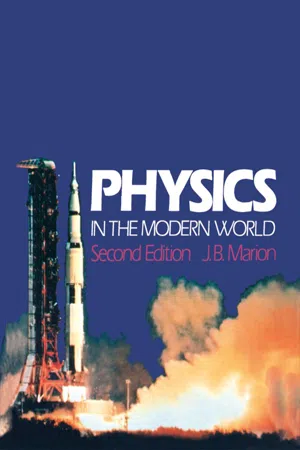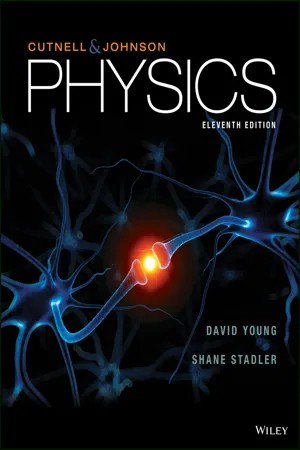Physics
Speed Physics
Speed in physics refers to the rate at which an object covers distance. It is a scalar quantity, meaning it only has magnitude and not direction. The formula for speed is distance divided by time, and it is measured in units such as meters per second (m/s) or kilometers per hour (km/h).
Written by Perlego with AI-assistance
Related key terms
3 Key excerpts on "Speed Physics"
- eBook - ePub
- Jerry Marion(Author)
- 2012(Publication Date)
- Academic Press(Publisher)
2MOTION
Publisher Summary
This chapter presents an overview of motion. It describes the motion of automobiles and planets. Acceleration is the change in speed per unit time. The speed of an object at any instant is equal to the slope of the distance–time graph. The acceleration of an object is equal to the slope of the speed–time graph. The chapter illustrates the connection between speed and acceleration. It further illustrates equations for the analysis of motion. When an object is dropped, the gravitational attraction of the earth causes the object to fall with continually increasing speed—the object is accelerated by gravity. The chapter discusses the vertical motion of an object moving freely near the surface of the earth. The vertical and horizontal motions do not affect one another. The chapter explains motion in two dimensions and discusses parabolic motion of an object.We live in a restless Universe. Everything around us—from the atoms that make up all matter to automobiles and aircraft to the distant galaxies of stars in space—undergoes motion. Every physical process involves motion of some sort. Because motion is such an important feature of every physical process, it is the logical subject with which to begin our detailed study of physical phenomena. The ideas developed here are used throughout this survey—in describing the motion of automobiles and planets, in discussing electric current, and in studying the behavior of atoms and nuclear particles. Motion is at the heart of every physical process.2-1 AVERAGE SPEED
Distance and Time
If an object is in one position at a certain time and is in a different position at a later time, we know that movement has occurred. How can we describe the details of movement in a meaningful way? When we take a trip by automobile and note the behavior of the speedometer, we see that we rarely travel very long at constant speed. For one reason or another, it is frequently necessary to slow down or speed up. By the time the trip is completed, we have traveled at many different speeds. But there is still one speed—the average - No longer available |Learn more
- Robert A. Pelcovits, Joshua Farkas(Authors)
- 2023(Publication Date)
- Barrons Educational Services(Publisher)
Speed Speed is, as always, the magnitude of the velocity vector. As explained above, the velocity vector can be written in terms of its components:Speed, the magnitude of this vector, is calculated using the Pythagorean theorem:The one-dimensional kinematics equations derived earlier are still valid and can be viewed as special cases of two-dimensional kinematics (when one of the components is zero). Additionally, it shouldn’t be too surprising that the one-dimensional kinematics equations derived in the x-direction are valid in the y- as well if we simply change the variables.Mathematically, you can see this from the fact that the two-dimensional vector definitions of velocity and acceleration can be broken down into one-dimensional definitions, which (in any given direction) are identical to the original definitions of velocity and acceleration given earlier.Because these original definitions are valid (for any particular direction), all the equations derived from them must also be valid (for that particular direction). For example, the following UAM equation was derived for one-dimensional motion earlier.According to the argument above, this is true in two dimensions for any motion with uniform acceleration:v = v0 + at valid only for uniformly accelerated motionThe Physical Significance of The Vectors
1.For the instantaneous velocity vector, the magnitude is the speed (a scalar), and its direction is in the direction of motion (tangent to the path of the object). The direction can be understood in terms of the fact that the displacement vector, r2 − r1 , approaches the tangent to the trajectory as Δt → 0, as illustrated in Figure 2.4 .Figure 2.4TIP The instantaneous velocity vector tells you which way and how fast the object is moving at that instant.2. - eBook - ePub
- John D. Cutnell, Kenneth W. Johnson, David Young, Shane Stadler(Authors)
- 2018(Publication Date)
- Wiley(Publisher)
speed to mean “instantaneous speed.”Check Your Understanding
(The answers are given at the end of the book.)- 2. Is the average speed of a vehicle a vector or a scalar quantity?
- 3. Two buses depart from Chicago, one going to New York and one to San Francisco. Each bus travels at a speed of 30 m/s . Do they have equal velocities?
- 4. One of the following statements is incorrect. (a) The car traveled around the circular track at a constant velocity. (b) The car traveled around the circular track at a constant speed. Which statement is incorrect?
- 5. A straight track is 1600 m in length. A runner begins at the starting line, runs due east for the full length of the track, turns around and runs halfway back. The time for this run is five minutes. What is the runner's average velocity, and what is his average speed?
- 6. The average velocity for a trip has a positive value. Is it possible for the instantaneous velocity at a point during the trip to have a negative value?
2.3 Acceleration
In a wide range of motions, the velocity changes from moment to moment, such as in the case of the sprinter in Photo 2.1 . To describe the manner in which it changes, the concept of acceleration is needed. The velocity of a moving object may change in a number of ways. For example, it may increase, as it does when the driver of a car steps on the gas pedal to pass the car ahead. Or it may decrease, as it does when the driver applies the brakes to stop at a red light. In either case, the change in velocity may occur over a short or a long time interval. To describe how the velocity of an object changes during a given time interval, we now introduce the new idea of acceleration. This idea depends on two concepts that we have previously encountered, velocity and time. Specifically, the notion of acceleration emerges when the change
Index pages curate the most relevant extracts from our library of academic textbooks. They’ve been created using an in-house natural language model (NLM), each adding context and meaning to key research topics.


